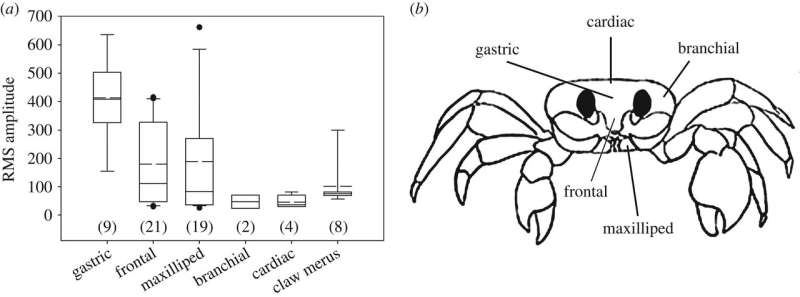September 11, 2019 report
Ghost crabs found to gnash teeth inside their stomach to ward off predators

A team of researchers from the Scripps Institution of Oceanography and the University of California has found that ghost crabs have a secondary means of communication—gnashing teeth inside their stomachs when threatened. In their paper published in Proceeding of the Royal Society B, the group describes their study of the crab and how they discovered the source of a secondary noise it made.
Ghost crabs are semiterrestrial crabs that live on shorelines in the tropics. They are scavengers and live in burrows in the sand. Prior research has shown that the crabs create a loud scratching sound when they are threatened—the sound comes from bumps near the joints rubbing together. But they also create another sound when their claws are outstretched (such as when the crab is very close to another animal), preventing them from rubbing the joint bumps. The researchers in this new effort set their sights on discovering how the ghost crab makes this secondary sound.
The team first set test crabs in an enclosure and watched as they reacted to various perceived threats. But doing so did not reveal the source of the secondary noise. There was no apparent rubbing or scratching that could account for it. Strongly suspecting that the noise was being generated internally, the researchers placed test crabs in an X-ray chamber capable of showing internal activity in real time. Doing so showed that the crab was grinding teeth in its stomach, creating the mysterious noise.
The teeth in the crab stomach are known as gastric mills, and are quite common among crustaceans. Normally, they are used for chewing food, like teeth in most animals.
The researchers report that their finding was the first-ever reported incidence of a crustacean using its stomach teeth to communicate, though they also note that some fish with teeth in their throats use them to communicate. The researchers also suggest their finding might not be all that unique—they suspect that other creatures with teeth in their gullets or stomachs use them to communicate with others of their kind or to scare off predators.
More information: Jennifer R. A. Taylor et al. Growling from the gut: co-option of the gastric mill for acoustic communication in ghost crabs, Proceedings of the Royal Society B: Biological Sciences (2019). DOI: 10.1098/rspb.2019.1161
Journal information: Proceedings of the Royal Society B
© 2019 Science X Network



















